2013 Space Horizons Conference Poster
Brown University, February 20 - 21
Poster presentation, 4 page PDF, 14.3MB last updated 2013 Feb 13 at 3pm PST
LaTeX source file last updated 2013 Feb 13 at 3pm PST
Notes: Please look at the PDF for the most accurate version. This page is a work in progress, and was imperfectly translated from the LaTeX source file. I will make more links to references Real Soon Now. You can find the images in the Attachments. Some are large. Best viewed at 300dpi . Some of these graphs and analyses require the big file of annotated two line elements from spacetrack.org , for which you must sign up to get access. Restrictions may increase in the future. Sign up and download what you can, for now.

Abstract
Paper thin satellites, precisely positioned by light pressure on switchable mirrors, self-assemble into megawatt arrays. Solid state technology advances permit robust survivability in high radiation. Applications include internet for the developing world, and centimeter-accurate space debris tracking.
large Stable operation in earth orbit limits the area to mass ratio. Ballast mass, scavenged from derelict rocket tanks, can minimize launch weight while reducing space debris.
Introduction
Most satellites convert solar power and information into signals transmitted to receivers on earth.
In essence, a satellite is a surface that collects solar energy, connected by sensors and computation to another surface directing radio energy into a narrow beam. Efficient satellites do this with the minimum possible mass.
Currently, satellites are built like aircraft, manually, from "proven" (obsolete) components in small batches. Consumer electronics are mass produced on automated manufacturing lines, packing bleeding edge technology into smaller and cheaper packages. Careful design and quality materials produce high reliability, feature-rich products more quickly and cheaply than satellite avionics.
Small transistors and wires save power. Billions of transistors replace software algorithms with optimized special purpose hardware, more immune to errors and radiation upsets.
Low cost mass produced semiconductors permit vast distributed systems of cooperative objects, working together like mesh Wi-Fi or cell phone networks, replacing the centralized resources of the past.
What if satellites got a solid state makeover, mass produced and networked like cell phones, optimized for the space environment?
Space Power for Computation and Radio
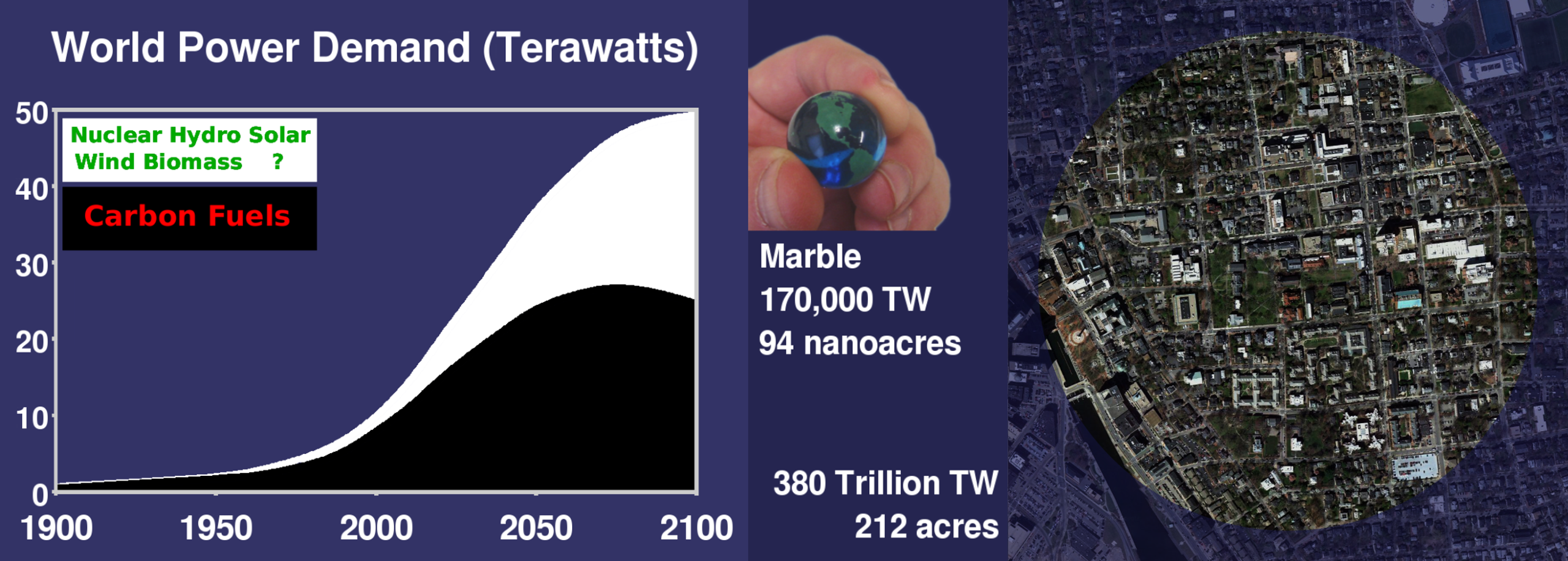
energy graph adapted from http://www.bakerinstitute.org/programs/energy-forum/publications/presentations/nanotechnology/Our%20Energy%20Challenge%20Smalley%20EnergyNanotech%20May%203-%202003.pdf
Land use: C. Reick, T. Raddatz, J. Pongratz, and M. Claussen, 2009: Contribution of anthropogenic land cover change emissions to pre-industrial atmospheric CO2, Tellus, doi:10.1111/j.1600-0889.2010.00479.x. Agricultural land changes was the main cause of anthropogenic CO2 runup until the mid 20th century.
As poverty diminishes worldwide, world power demand skyrockets. The earth intercepts 170,000 terawatts. Nature evolved to use most of the terawatts reaching land.
The sun emits 380 trillion TW into empty space. If 170,000 TW was proportional to a marble, the sun's total output is proportional to 212 acres (50% larger than the Brown University campus) compared to that small marble. With all that high quality, continuous power going to waste, why should we diminish nature's share of that tiny marble?
Data centers consume 3% of US base load generation, and the fraction grows rapidly, in spite of efficiency improvements. What if we power future data center growth with space solar energy, in space? .
Note: Jeremy Rifkin disputes the 3% number, and told me in 2012 that it was "only 2.2%" [personal conversation]. Kevin Kelly told me in 2012 that the amount of computing in the world doubles every year [personal email]. The smart chip designers at Intel are indeed delivering a lot more computing per watt every year, but Intel's chip output measured in watts consumed is still rising, on top of a legacy base that remains online and drawing power. Some cynics say the reason power isn't growing even more rapidly is that Intel sales are down because of the economic recession.
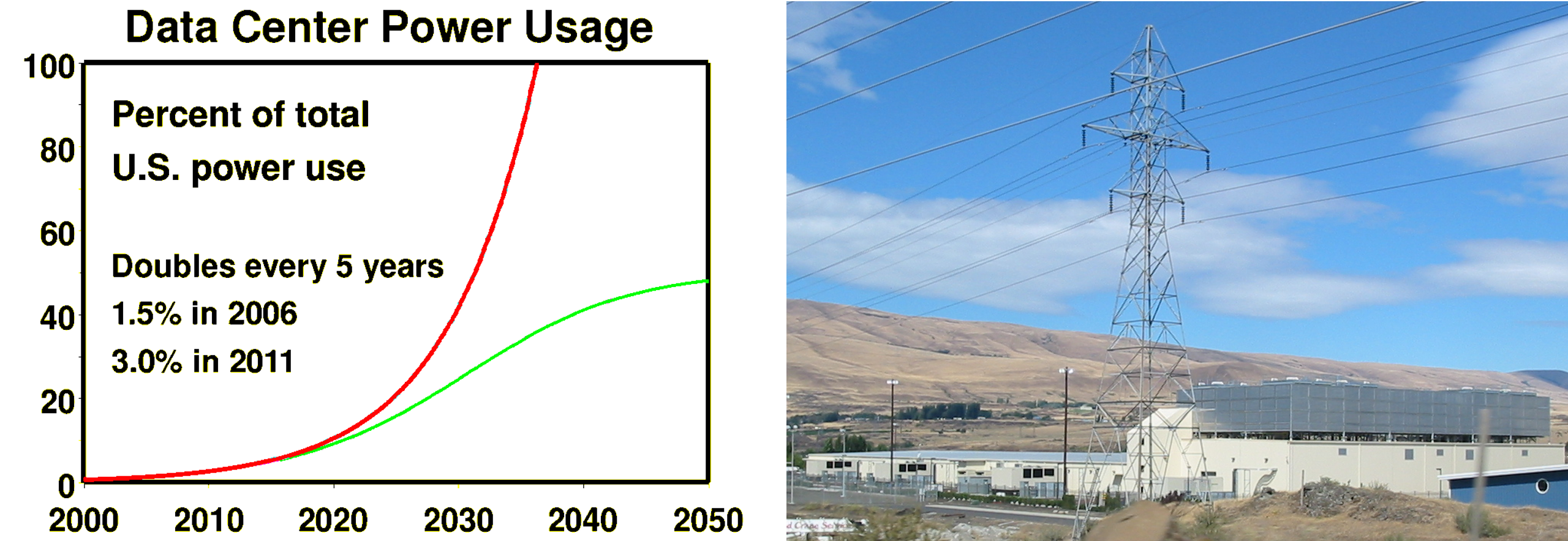
photo of Google data center, The Dalles, Oregon, taken by author ca. 2008
Terrestrial data centers require cases, racks, cabling, power conversion, cooling, buildings, land, transmission lines, power plants, fuel, and continental-scale optical fiber networks. If we deliver space solar power to the terrestrial grid, we add huge transmitters and rectennas.
Computers in space don't need all that. With reliable sunlight and a deep space heat sink, they need little more than solar cells, silicon chips, circuit board runs, and gossamer structure to hold them together in microgravity. Data from space can be delivered anywhere on earth: ships, aircraft, remote sensors, temporary outposts and remote villages, and also to other satellites in orbit.
Thinsats
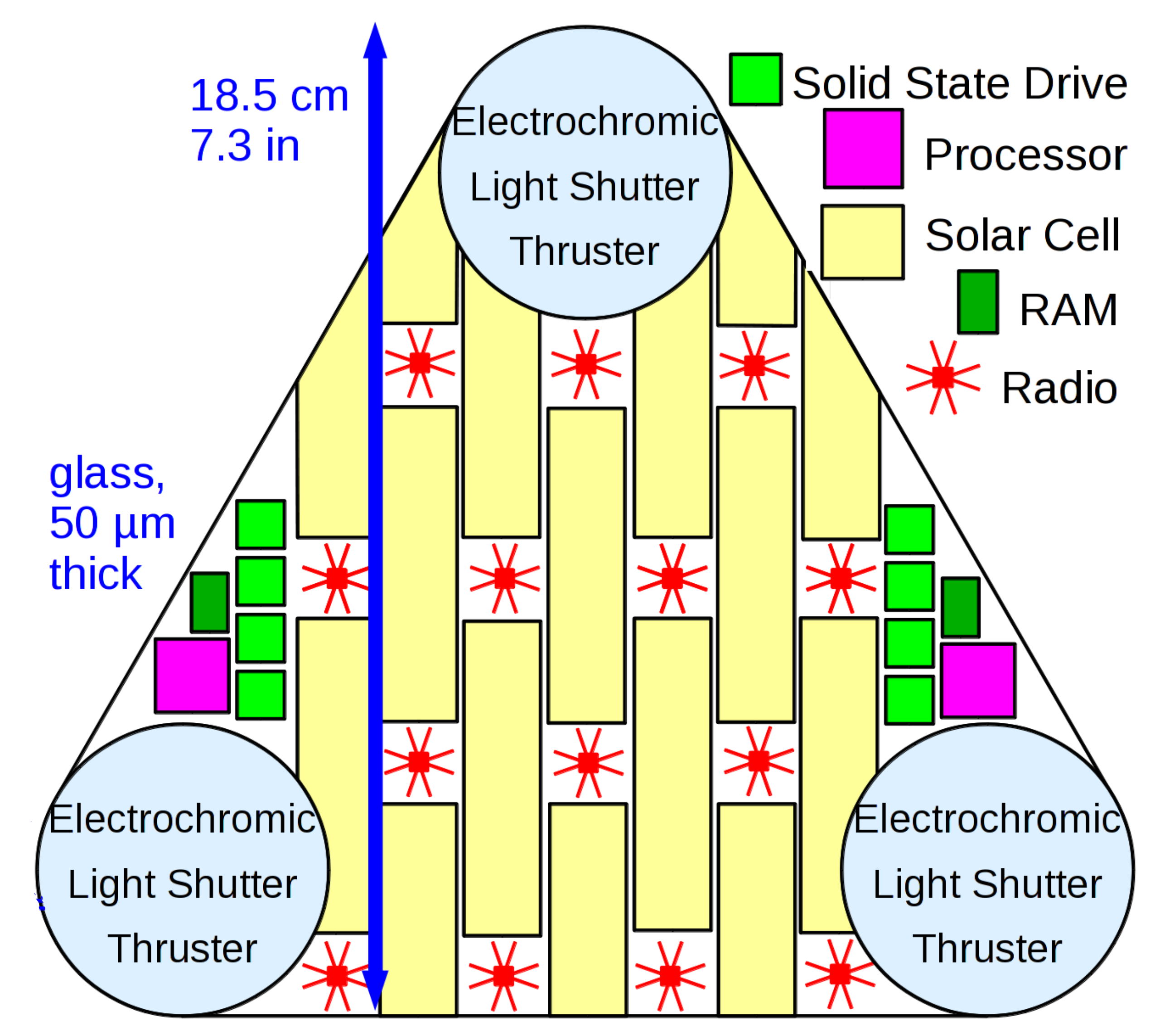
Here's a one pager with a 1X drawing of a thinsat
Very thin satellites ("thinsats") maximize power with minimal launch weight. Large area thinsats can share resources such as time references and maneuvering, and use narrow-beam phased-array techniques. Too light, and orbit eccentricity must be high to compensate for light pressure, interfering with other orbits. Too wide, and pitch/yaw turns are slow, and gravity gradient torques are difficult to correct. Reasonable dimensions are 20 centimeters across, and 8 m2/kg.
One thinsat is almost useless, but large arrays can out-perform multi-ton satellites. Server sky thinsats weigh three grams, so an array of 33,000 thinsats weighs 99 kilograms, and makes 100kW of power from sunlight, 100 times the power to weight ratio of a big comsat. Thinsats deploy into constellations 100 meters across or larger. Over time, arrays can grow or shrink, change shape, or be reprogrammed for different functions. There is no upper limit on array size, though large arrays must be sparse so radio signals and sunlight can penetrate them.
Thinsat substrates are circuit boards made from triangular sheets of aluminum, with shaped surface cavities holding strips of indium phosphide solar cells and silicon integrated circuits such as processors, memories, and radios. The ground plane on the back side will have arrays of hundreds of radio chips, each surrounded by slotted antennas. Multilayer circuit board traces thread between the slots.
Launch is stressful, so thinsats are densely stacked for launch, as strong as a cylinder of aluminum. Thinsats are formed with slight curvatures, actually two different curvatures that alternate in the stack like Belleville springs. This creates a small force that gently pushes them apart when they deploy from the stack in orbit.

drawn with sh01.c and the libgd library
Stress and curvature analysis remains to be done
Light Pressure
The thinsat corners are three large switchable mirrors acting as thrusters. The mirrors are thin films of electrochromic material, which switch between transparent and reflective in fractions of a second, using a solid-solution electroplating process. Light pressure is 4.56 μ N/m2. Pass-through light creates no force, reflected light creates double the force. Thinsats are mostly opaque, with constant thrust, but the thrusters allow individual thinsats to maneuver relative to their neighbors, and turn sideways to the sun, changing incoming light pressure, and creating sideways forces.

echrome04.c source file - uses png2apng to make a flash video
The electrochromic window shown switches slowly; faster switching (perhaps using more current) will help if somehow the thinsat is set spinning or tumbling, perhaps by an impact.
Three 5cm corner thrusters on a 3 gram thinsat weigh 600mg and deliver \approx 20 nanonewtons of average thrust, throttleable to a fraction of a nanonewton over a fraction of a second. The thruster I_{SP} is 10,000 seconds for 10 years in orbit.
Thrusters are segmented, allowing fine tuning of the thrust, and increasing survivability to micrometeoroid punctures.
The thruster acceleration for a sun-oriented 3 gram thinsat averages 7 μ m/s2. Turns between sun-oriented and 60° sideways can produce an additional 6 μ m/s2 of acceleration over an orbit for long distance maneuvers.
Start and |
Thrust |
Distance |
|
stop time |
fraction |
moved |
|
0.2 sec |
0.1 |
7 nm |
optical position tweak |
1.0 sec |
1.0 |
1.7μm |
microwave position tweak |
6 min |
1.0 |
20 cm |
occultation avoidance |
30 min |
1.0 |
5 m |
precision debris avoidance |
7 hours |
1.0 |
1 km |
crude debris avoidance |
6 days |
1.0 |
444 km |
1 degree around m288 orbit |
41 days |
1.8 |
40,000 km |
180° around m288 orbit |
Thinsats are torqued and turned with differences between thrusters, accelerating one side of the thinsat differently than the other side. A 20 cm thinsat can make a 45° turn and stop in 6 minutes.
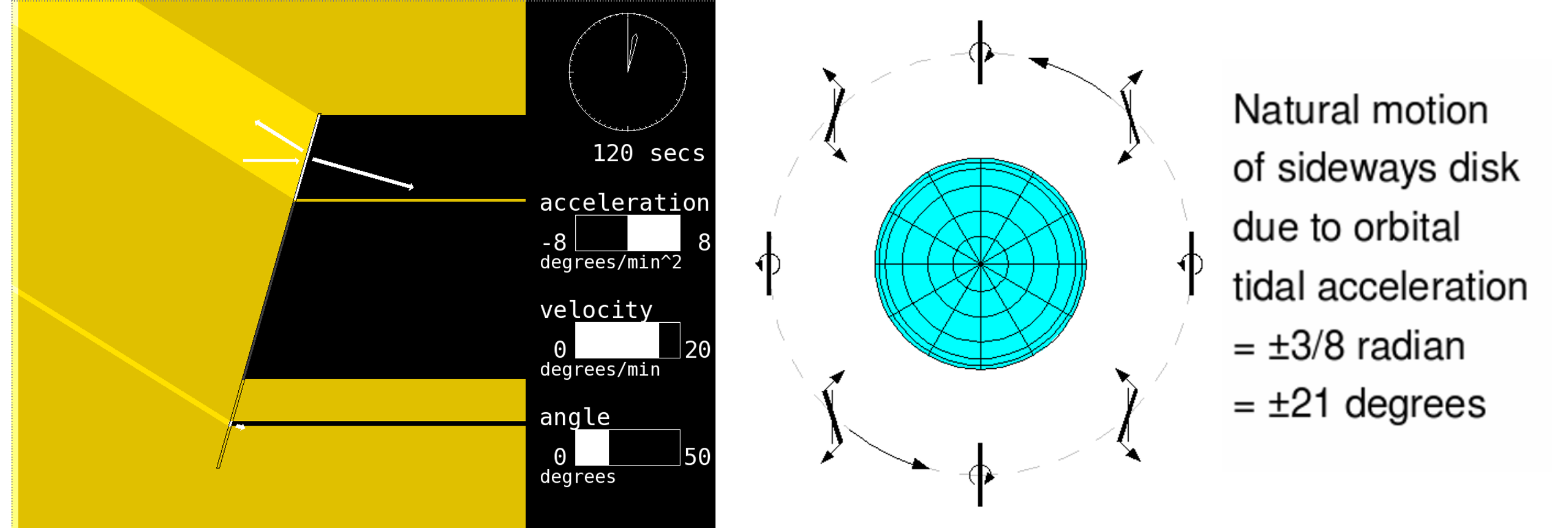
ss6a.c turn animation, requires libgd
Continuous torque is required to counteract tidal forces. The only stable position for a thinsat is edge-on to the center of the earth. Continuous sun orientation requires torques at the 3 o'clock and 9 o'clock positions of the orbit. Light pressure cannot correct the gravitational torque of thick and heavy thinsats.
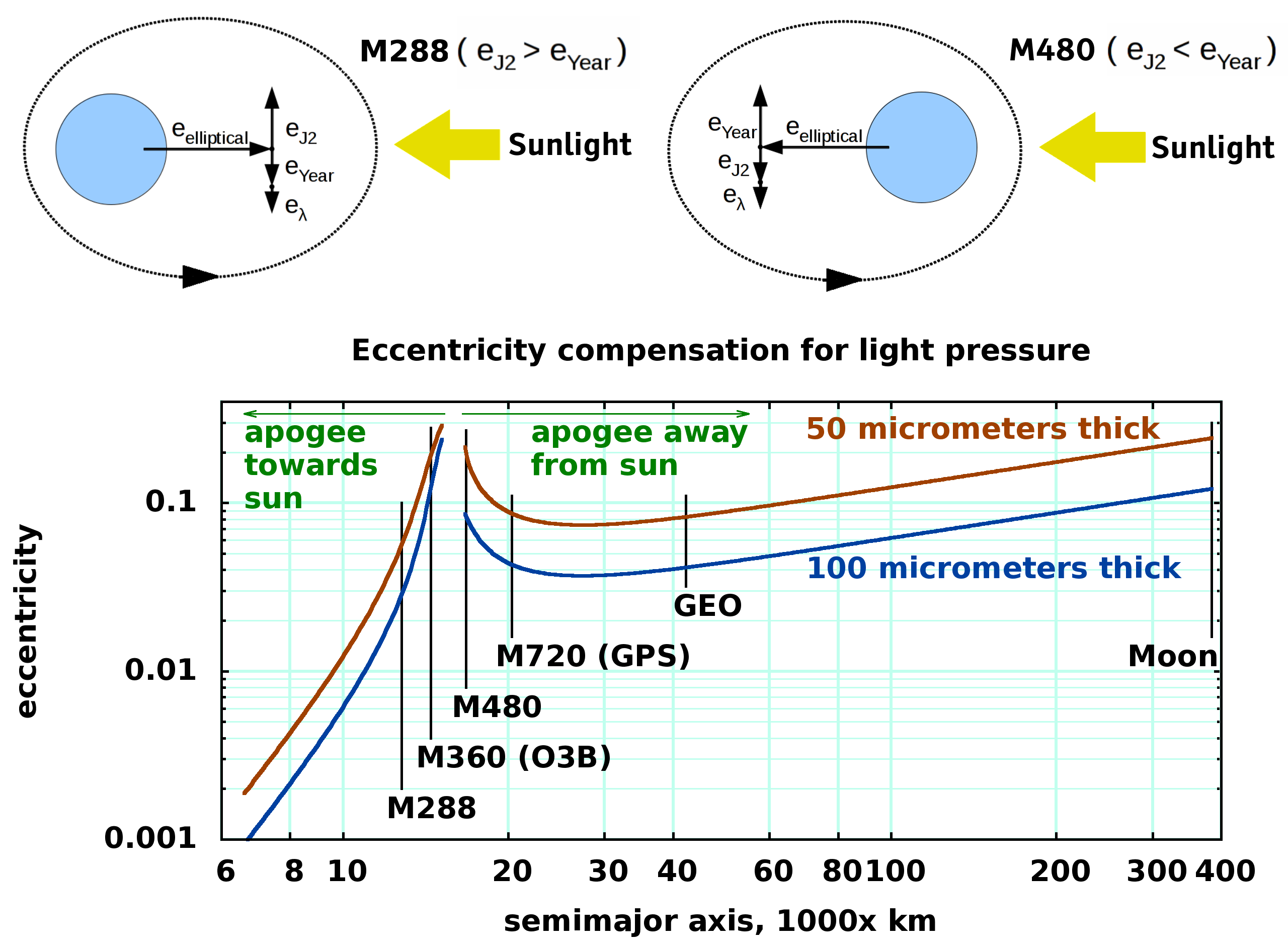
Light pressure can destabilize orbits. Light pressure subtracts \Delta V from the sunbound side of the orbit, and adds \Delta V to the the outbound side. This modifies a circular orbit into an ellipse, driving apogee and perigee perpendicular to the sun. If this change in eccentricity is added to an ellipse with a sunwards perigee, the eccentricity and the orbit will precess eastward. A properly chosen elliptical orbit precesses {360°} per year, with perigee following the sun through the sky.
The oblate earth adds a J_2/R^3 term to the gravity field, also precessing perigee eastward, 360° per year at 15000km radius. Below this altitude, the precession is too fast, so light pressure precession is subtracted using a sunwards apogee. Above 15000km, light pressure precession dominates, and a sunward perigee orbit should be chosen. Higher orbits have lower orbital speeds, so light pressure has a greater effect, and the orbit must be more elliptical to compensate.
The M288 orbit

population histogram: http://www.radicalcartography.net/index.html?histpop, thank you for permission from Bill Rankin . . . pc02.c program to add coverage curves
The 12789 km radius M288 orbit makes exactly 5 orbits per day relative to the ground, for a 288 minute ground repeat time. M288 is a compromise between northern latitude visibility (55°) and round trip ping time. Most of the world's population is south of 55°N .
The M480 orbit (three repeats per day) is visible farther north, but ping time is slower and launch \Delta V is higher. The M720 orbit is occupied by GPS and Glosnass, and the M360 orbit is slated for the O3b satellites. Both M360 and M480 are close to the 15000km light pressure instability.
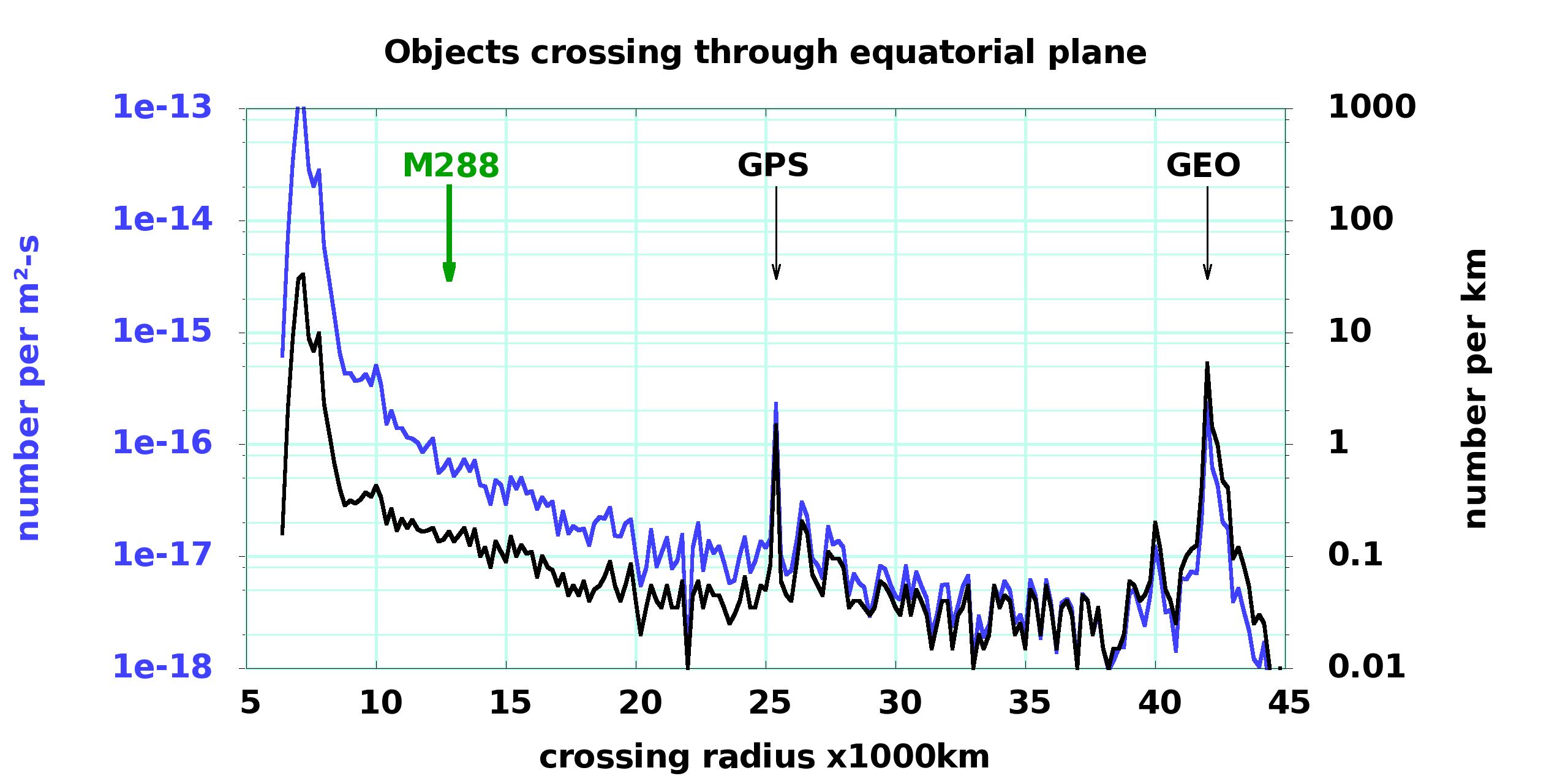
crosser.pl . crosser.gp you will need perl, gnuplot, and a subscription to the spacetrack database
The NORAD spacewatch database lists about 13000 tracked objects. The population of tracked objects drops rapidly with altitude. The flux rate drops faster, as equatorial plane crossings are spread out over a larger orbital radius and longer orbital periods.
Equatorial orbits have lower average closing velocities with objects in inclined orbits. Objects in opposing polar orbits can close with each other at twice orbital velocity.

orbit04w.c two orbit source, requires libgd
tor08.c toroid orbit source, requires libgd
The sidereal period of an Earth orbit is T = 2 \pi \sqrt{ a^3 / \mu } , where a is the semimajor axis and \mu is the Earth's gravitational parameter. The period is the same for all orbits with the same semimajor axis.
We can map many elliptical orbits with identical periods onto a toroid around a central orbit, packing them closely with no chance of high speed collisions between them.
3 dimensional arrays mapped onto these orbits will skew towards apogee as they move around the orbit, and also make one rotation around their center orbit axis as they make one orbit.
Cooling and Temperature stress
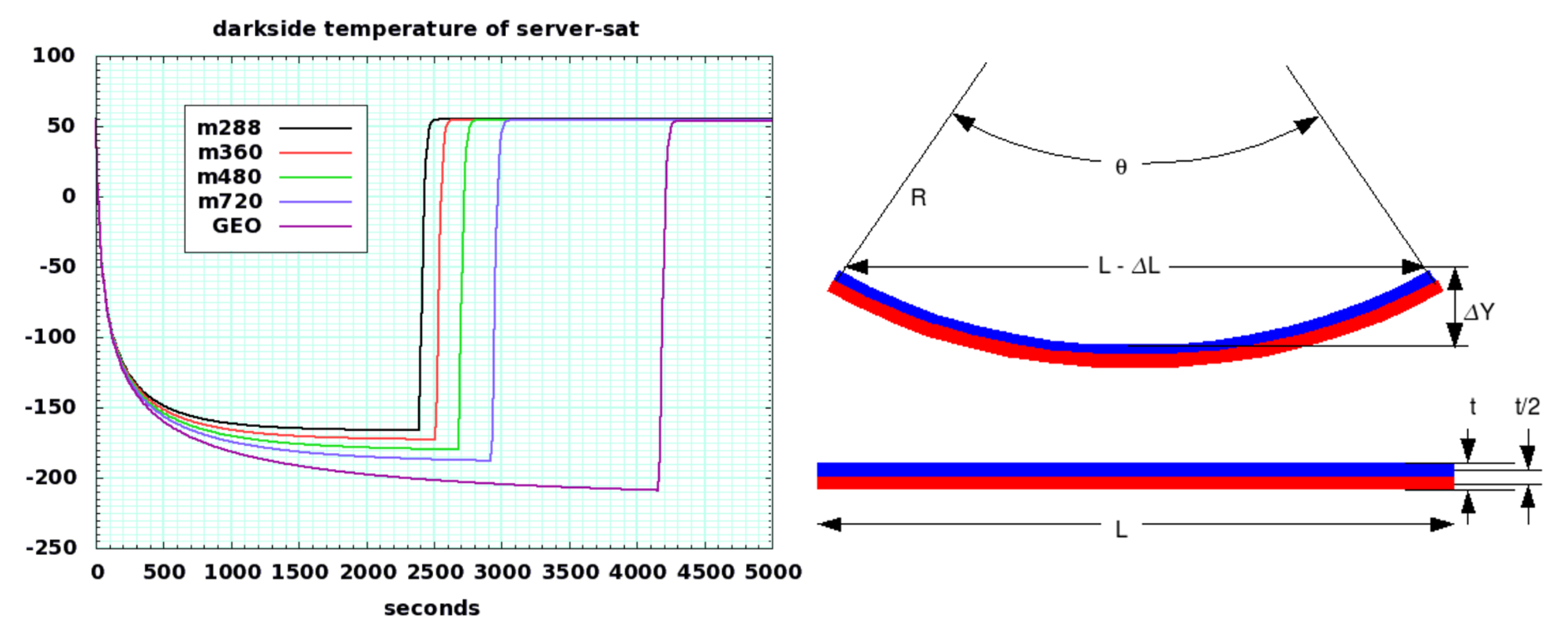
darkside0.pl source, darkside0.gp requires perl and gnuplot
Manufacturing#Curl curvature analysis
cooling analysis work in progress
M288 objects spend 40 minutes per orbit in solar eclipse, without power. Their high surface-to-volume ratio makes them cool rapidly by black body radiation, reaching equilibrium with deep space and Earth's night sky infrared emissions.
Since the materials have different thermal expansion properties, there will be thermal stresses between objects and on wiring and connections. Differences between average front and back side expansion can cause curling and warping of thinsats.
Radiation
The M288 orbit is in the van Allen belt. Thinsats are unshielded, so electronics and solar cells get huge radiation doses. Recent semiconductor advances provide solutions.
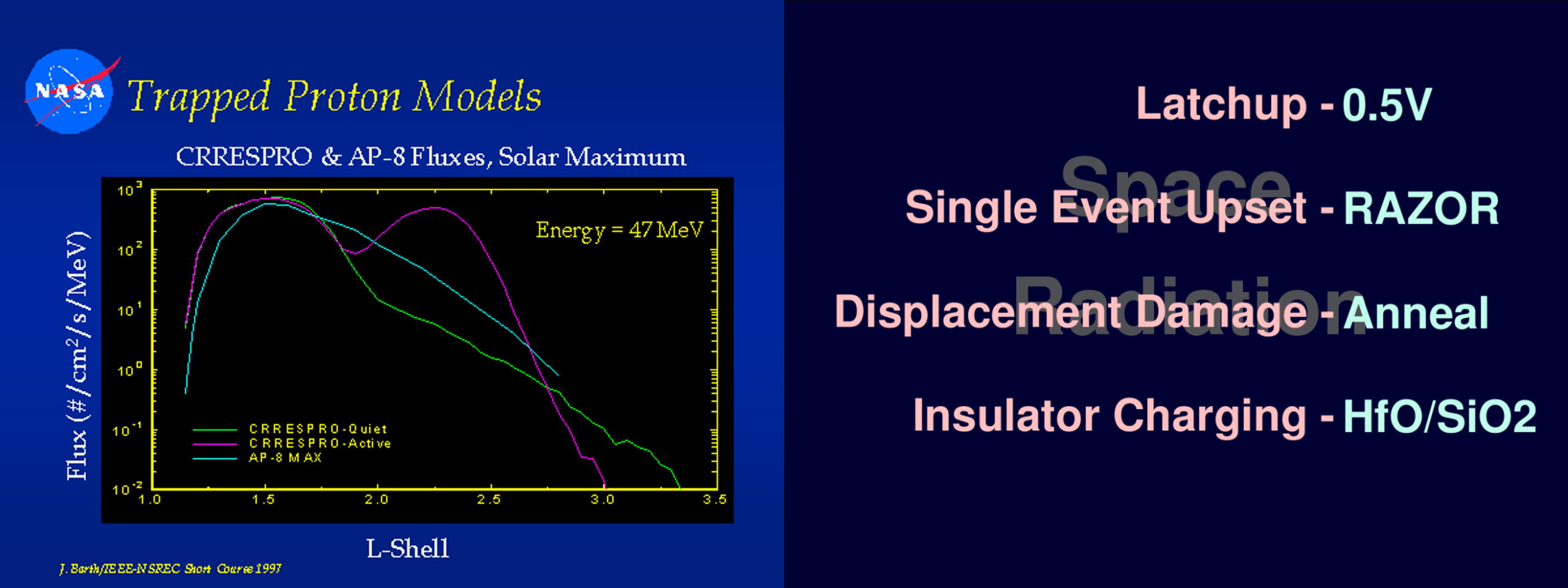
graph source http://radhome.gsfc.nasa.gov/radhome/papers/SC_nsrec97.pdf quoting Gussenhoven, IEEE Trans on Nuclear Science Vol 43 no 2 April 1996
Ionizing particles can cause latch-up, but not at modern power supply voltages below 1 volt. Particle hits can flip bits, but RAZOR "detect error and recompute" techniques can compensate, while increasing power performance.
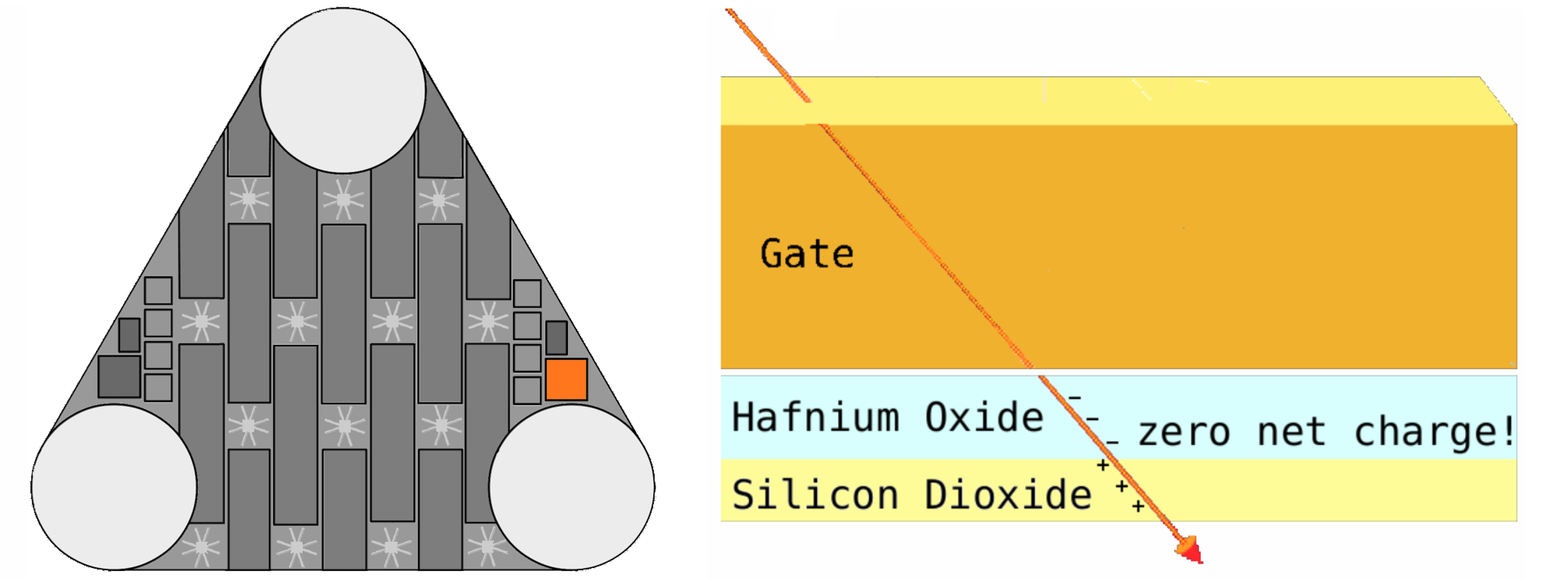
Annealing, briefly cooking the semiconductor lattice, can heal displacement damage caused by high energy particles. Lateral thermal conductivity through the very thin substrate does not spread heat, so all 4 watts of a chipsat can be redirected to heat one small region above 400C. The figure shows the heating of one of the solid state memory chips.
Gate charge trap effects can be almost eliminated by the new Intel hafnium oxide process. Particle tracks leave a trail of trapped electrons in the HfO film, and a compensating track of trapped holes in the SiO_2 beneath it. Such transistors withstand doses of many megarads without noticable voltage threshold shifts.
also see Threshold Shift Graph
Thin, graded junction indium phosphide solar cells are rad hard, as are highly-doped deep submicron transistors. Thinsats contain no radiation-and-UV-sensitive plastics. Other materials will need evaluation.
Phased Array Radio
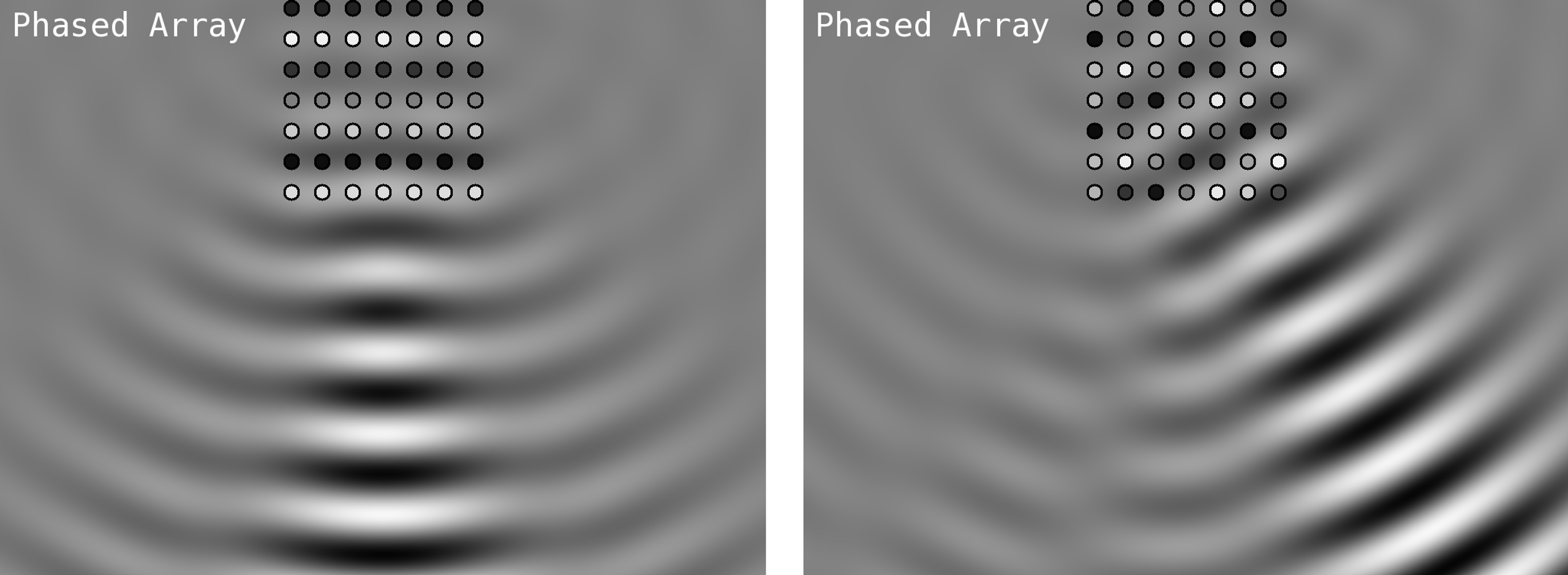
Phased array transmitters sum the signals from many precisely timed emitters to form a beam. Electronically changing the phase of the emitters steers the beam in nanoseconds. A 100 kg array with 33,000 3 gram thinsats and spread out over 100 meters can focus kilowatt pulses onto a ground spot 1 km wide and 10,000 km distant. Thousands of different pulses in different directions can be emitted simultaneously, by superposition.

Averaging over thousands of emitters results in tight and accurate power beams. However, a regular array that is widely spread out sprays 99% of the energy in all directions, and focuses some of it into grating lobes, making high power interference in the wrong places. Intentionally dithering thinsat positions into a non-uniform grid smears out interference, reducing peaks to acceptable levels.
Tracking space debris, recycling rocket tanks
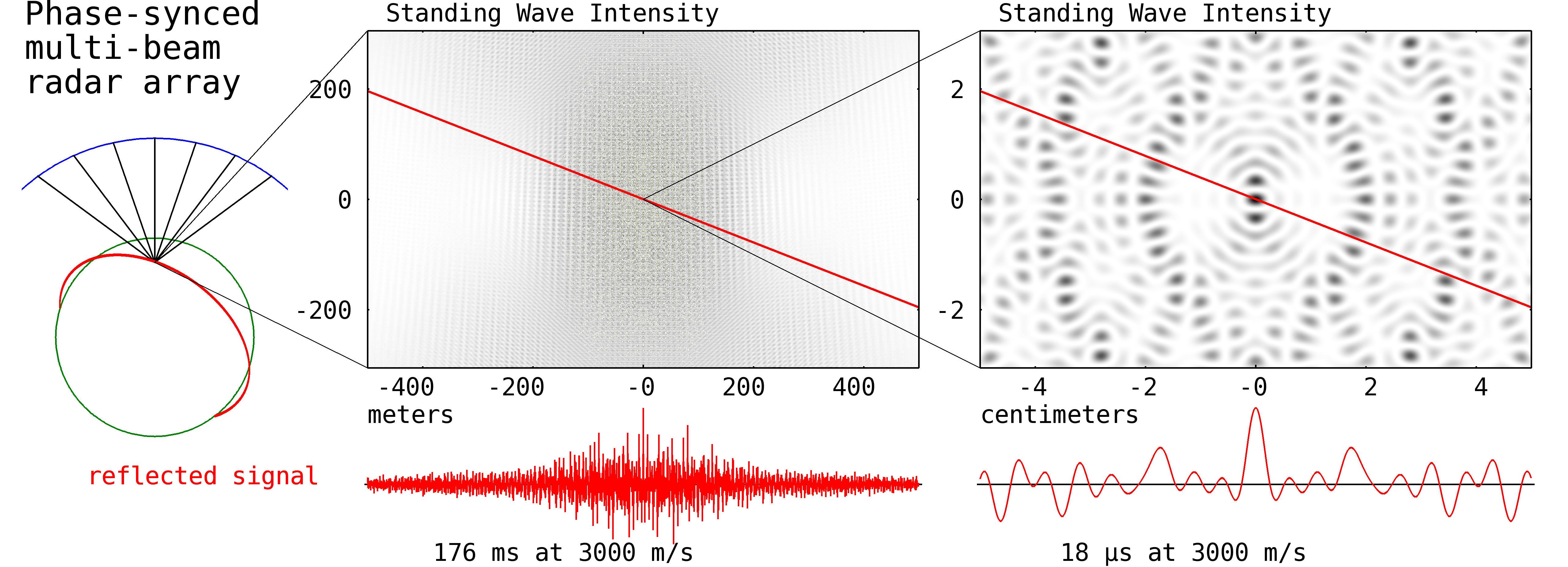
source file ar06.c
Widely spaced arrays to show resolution. We will probably use much more closely spaced arrays, which due to the reciprocal refraction will make bigger spots
Modern radars emit chirps, complex pulses spread in time and frequency, with receivers correlating the return energy to the chirps. This detects much lower amplitude signals with high timing accuracy.
Many server sky arrays can be synchronized and focus narrow-band continuous microwave energy on a small volume of near-earth space, creating three dimensional interference patterns, standing waves in space. As an object orbits through that volume, the energy it reflects will be modulated by the changing field, creating a time-varying return similar to a radar chirp. Different objects in different orbits will emit different signatures, and a powerful parallel computation engine can correlate for all the expected signatures simultaneously.
The drawing above shows seven widely separated arrays looking at a half-kilometer region of space with centimeter resolution. Compacting the arrays expands the search region, and closing the orbital separation between arrays looks for larger objects. Once objects are identified and their rough orbital parameters tracked, we can use other array configurations to characterize object position and velocity to centimeter accuracy, measuring tumble and estimating mass from the long term response to drag and light pressure.
Server sky can use this expanded collider database to plan maneuvers long in advance. But a large database will also protect big satellites with limited maneuvering fuel. When we can precisely predict where billions of large and small colliders will be, we can make tiny micrometer-per-second thrusts on the big birds, confident of a 10 meter miss six months in the future. Today, NORAD tracks larger objects with kilometer short-term accuracy, only marginally useful for avoidance maneuvers.
Capturing ballast mass
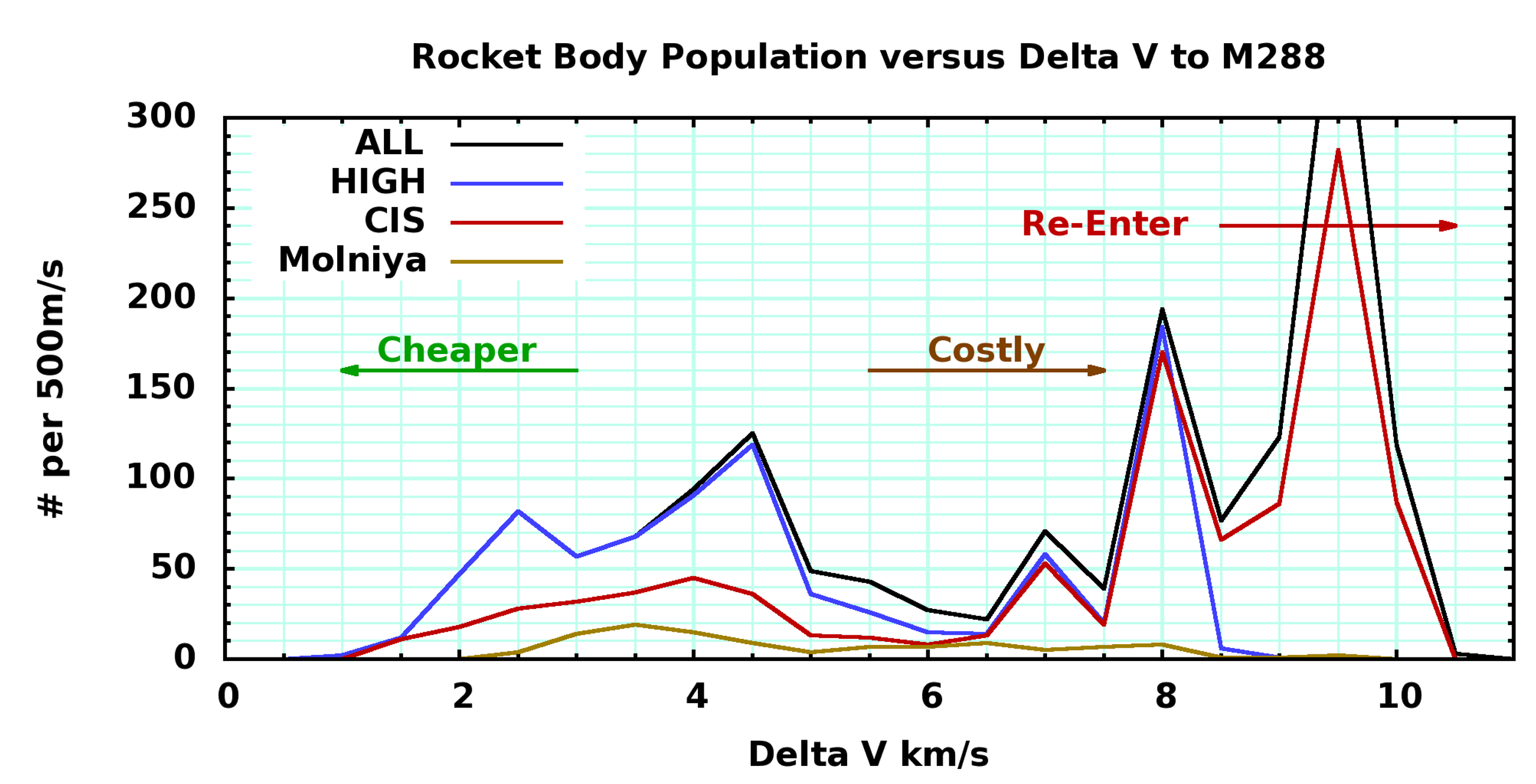
insertrb.pl perl source . rb.gp gnuplot source
Instead of mere avoidance, we can collect the derelict objects, then recycle or re-enter them. NORAD tracks 1500+ spent upper stages, with acres of aluminum tank.
Specialized satellites with high I_{SP} VASIMR thrusters and powerful lasers can cut the skins and tanks into penny-sized ballast mass for future ultra-thinsats. The ballasts are ferried to M288 to attach to new ultralight thinsats. Every kilogram delivered to M288 with fuel-efficient space tugs enables an extra kilowatt of ultra-thinsat.
Many of those rocket bodies are far from M288, in LEO and MEO orbits accessible to electrodynamic tether EDDE capture systems. Those objects can be collected into "junkyards" in low orbit for other re-uses, or de-orbited and re-entered. Accurate server sky radar will help mission planning for EDDE as well as detect and characterize potential tether-cutting colliders.
Conclusion

The spectacular transistor density increases driving Moore's Law are slowing; computing cost is now driven by energy costs, not transistor cost. The spirit of Moore's law, providing exponentially increasing computing value per dollar, can continue in space for decades. Space energy is unbounded, and the cost of collecting it will drop with efficiency improvements, mass reductions, and launch cost reductions.
Rocket designs are already optimized. Most re-use proposals are misconceived, trading expensive payload mass fraction and complicated logistics for cheap tank aluminum. Logistic improvements from scheduled high traffic expendable launches will reduce launch costs, but Tsiolkovsky's exponential law will always make fuel-carrying launchers more expensive than the resulting payload energy.
Server sky greatly increases the productivity of a kilogram in orbit, making hundreds of launches a day economically attractive. That creates a market for electrically powered alternatives to rockets, such as the coilgun launcher prototypes built by E. F. Northrup in the 1930's, or more recent proposals such as the space cable and the launch loop. When space solar power provides terrestrial grid power to launch more space solar power collection systems, power costs will drop and launch capability will grow exponentially, while reducing the environmental costs of global abundance.
note 1: I've been asked to mention other kinds of speculative launchers: laser launchers, gas guns, scramjets, etc. The main point of server sky is that even expensive rockets are dirt cheap if they deliver high value per kilogram. For six orders of magnitude cost cutting over the 40 years (Moore's Law is the LAW!) we will need better launchers eventually. More importantly, we must minimize the environmental effects of launching megatons of thinsats into space, and no rocket or gun will do that. I've worked on Launch Loop since the 1970's - I won't live to see one built, because many other things must happen first: loop power storage, enormous market growth, Asian environmental awareness. So, assume that 20X of the launch cost reduction comes from massive market growth, cutthroat competition, and logistic improvements in rocket launch, compensating for a 2X cost increase due to rising fuel cost (which in 2013 is a trivial fraction of launch cost). THEN comes the zero exhaust alternatives.
note 2: Learning Curve - in the electronics industry, we observe that a factor of two in cost reduction is associated with a factor of 10 in volume (and a factor of 5 in revenue ). The causality goes both ways. So a 10x drop in launch cost per ton takes us from perhaps 100 tons per year (WAG) to 200,000 tonnes per year (including the beginning of lunar ballast launches). If we can improve thinsats to 3 watts per gram assembled, then half of the 200 kilotonnes is 300 GW per year of thinsats, and trillion dollar revenues. That will attract a LOT of investment, and pay for the development of new launch systems at least as attractive as the launch loop. There's no financial incentive to develop exotic new systems now; indeed, when Elon Musk talks about crazy stuff like air launched liquid fuel rockets ( wrong launch angle! structurally absurd! ullage! logistics!), it seems likely that he is bamboozling his competition rather than seriously considering diverting the resources away from streamlining Falcon operations.
